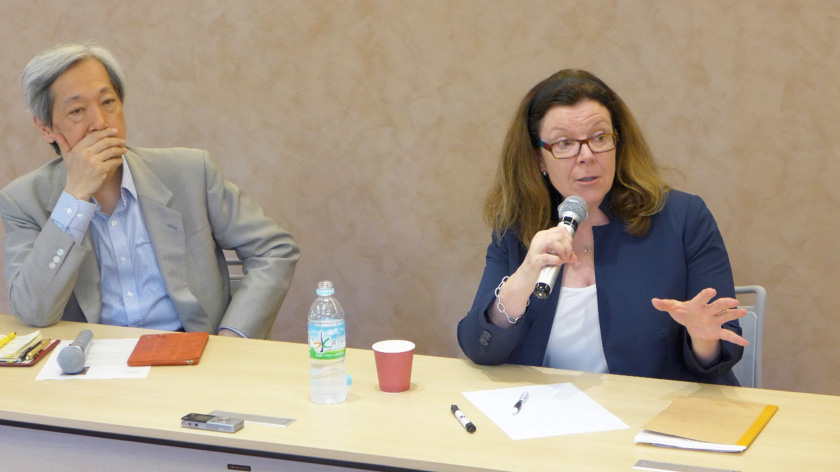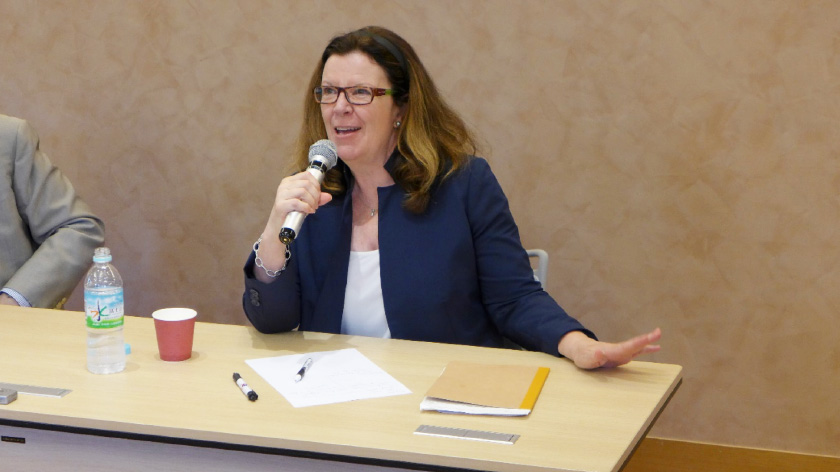SSU Forum with Dr. Sheila Smith
| Date: | Friday, June 23 2017, 10:30-12:00 |
|---|---|
| Venue: | Seminar Room, 3rd Floor, Ito International Research Center |
| Subject: | “The U.S-Japan relations in the age of the Trump administration” |
| Lecture: | Dr. Sheila Smith, Senior Fellow, Council on Foreign Relations |
| Language: | English |
| Hosted by: | Security Studies Unit, Policy Alternatives Research Institute, the University of Tokyo |
The Security Studies Unit was honoured to host a talk delivered by Dr. Sheila Smith, Senior Fellow at the Council on Foreign Relations, Washington, D.C. The talk, entitled “The U.S-Japan relations in the age of the Trump administration” was aimed at exploring the possible trajectories of new US administration in terms of foreign policy in East Asia, with particular regard to the evolution of US-Japan relations.
Professor Fujiwara, Director of the SSU, chaired the session, and introduced the speaker as one of the most distinguished scholars on US-Japan relations, who has authored fundamental work for anybody studying Japanese foreign policy, the alliance between the two countries, and how both are affected by domestic political change.

Dr. Smith thanked the host, and started her talk by recalling the previous forum right after the US presidential election in November 2016. At that time, there was a great shock for the unexpected result, but also great uncertainty about its consequences. The shock came especially because Trump’s election arrived as a result of an unprecedentedly divisive electoral campaign, which challenged worldviews and values a large part of US citizens used to be taking for undisputable. Among foreign policy experts, a significant disruption of US foreign policy was feared, if the new administration was really going to implement the slogans Trump used during the campaign, which indicated a significant disengagement from defence commitments both in Europe and Asia.
What is the situation five months after the new President’s inauguration? Dr. Smith argued that in many respects this administration is roughly following the established track of previous presidents, but with some differences. The transition to a new administration is never an easy passage, and it requires a considerable amount of time before it can be deemed to be complete, usually between six and nine months from the inauguration. In the case of Trump however, the situation appears even more difficult than usual, mostly because of numerous experts and policy makers, even from the Republican party, antagonised him during the campaign. As a result, Trump has come to the White House with a significantly reduced range of choices in terms of personnel to man even some of the key positions in his administration. As of today therefore, numerous positions are not yet covered and the government is certainly understaffed.

From a more explicit policy perspective, Trump, like his predecessors, has used his first hundred days to meet a number of electoral policies which the President can deliver on his own authority by means of executive orders. Trump has started the re-negotiation process of NAFTA, withdrawn from TPP, and issued the travel ban from selected Muslim-majority countries. From all this is clear that the President is mostly focused either on domestic issues or on trade, while more traditional questions of diplomacy and foreign policy do not rank particularly high in his agenda.
Coming to the point of Japan-US relations, Dr. Smith remarked that Prime Minister Abe clearly took some risk while venturing in a meeting with Trump right after the election, but it appears that that move has paid off in terms of building a quite positive personal relation between the two leaders, which has good prospects to be positive for Japan. This has become more visible with the very first steps for the top foreign policy officials, Defence Secretary General J. Mattis and State Secretary R. Tillerson, who promptly visited Tokyo and brought reassuring messages about the US continuing commitment to Japan’s security. These developments however took place largely in the context of an increasingly difficult situation in North East Asia given the North Korean threat, manifesting itself in repeated missile tests.
Comparatively speaking, at the moment the relations between Japan and the US appear to be significantly better than the ones with allies in Europe. Japan has three important channels at strategic level, namely: 1) a good personal dialogue between Prime Minister Abe and President Trump; 2) the perspective of the 2+2 meeting (foreign and defence ministers); 3) high-level trade discussions.
When it comes to a more general foreign policy for Asia, Dr. Smith regards the emergence of a veritable East Asia strategy in the Trump administration as unlikely, at least in the next few years. There are more chances to see a comprehensive trade strategy, rather than a grand strategy in a traditional sense. Problems are in any case arising, and will arise in the future, due to the North Korean issue, which may reverse the order of priority if the situation started to escalate. This also leads to the other emerging elements of Trump’s engagement in East Asia, namely his China policy. At the moment, it seems that the White House is expecting Beijing to pressure Pyongyang, and other options are going to be considered should China not meet Washington’s expectation within a certain date.
Finally, Dr. Smith talked about her thoughts on the possible trajectories of the Trump administration, articulating three different scenarios: 1) It may be that the election of Trump indicates an epochal shift in US foreign policy towards a systematically more national-oriented calculus of interests, which shall replace liberal internationalism. 2) Despite a bumpy transition, this administration will eventually return to the more usual track of US foreign policy of the last few decades. 3) As the Trump administration has challenged fundamental values, it will remained permanently disrupted, unable to lead, and unable to implement any real strategy.
At the moment there is not enough evidence supporting the first scenario, while the other two appear to be more probable. Time will tell.

